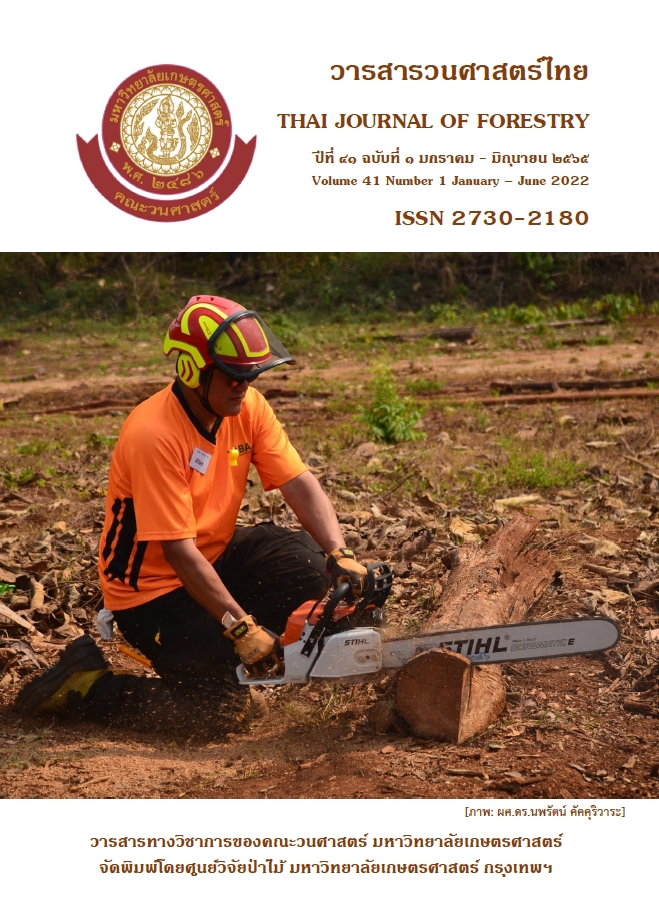แนวทางการจัดการสวนป่าอย่างมีส่วนร่วม กรณีศึกษา สวนป่าคลองตะเกรา
Main Article Content
บทคัดย่อ
การวิจัยในครั้งนี้มีวัตถุประสงค์เพื่อศึกษาความคิดเห็นและการมีส่วนร่วมในการจัดการสวนป่าคลองตะเกรา และการวิเคราะห์แนวทางการจัดการสวนป่าอย่างมีส่วนร่วม โดยการสัมภาษณ์กึ่งโครงสร้าง การสัมภาษณ์กลุ่มตัวอย่างด้วยแบบสัมภาษณ์ จากชุมชนรอบพื้นที่สวนป่าคลองตะเกรา จำนวน 7 หมู่บ้าน ทำการสุ่มตัวอย่างแบบหลายขั้นตอน มีหมู่บ้านที่ทำการศึกษา จำนวน 4 หมู่บ้าน จำนวนครัวเรือน 274 ครัวเรือน และการประชุมกลุ่ม กำหนดแนวทางการจัดการสวนป่าอย่างมีส่วนร่วม ด้วยการวิเคราะห์ปัจจัยแวดล้อม (SWOT Analysis) และตารางโทว์ (TOWS Matrix)
ผลการศึกษา พบว่า ชุมชนมีส่วนร่วมในกิจกรรมต่าง ๆ ของสวนป่าค่อนข้างต่ำ เพียงร้อยละ 29.93 มีระดับความคิดเห็นต่อการได้รับประโยชน์จากสวนป่าอยู่ในระดับปานกลาง ( =3.13
0.94) ระดับความคาดหวังต่อด้านการดำเนินงานของสวนป่าอยู่ในระดับสูง (
=3.55
0.80) ระดับความคาดหวังต่อด้านความสัมพันธ์ระหว่างสวนป่ากับชุมชนอยู่ในระดับสูง (
= 3.47
0.83) และระดับความคาดหวังต่อด้านการมีส่วนร่วมในด้านการมีส่วนร่วมในการจัดการสวนป่า อยู่ในระดับสูง (
= 3.51
0.81) ผลการวิเคราะห์วิเคราะห์ปัจจัยแวดล้อม (SWOT Analysis) และตารางโทว์ (TOWS Matrix) สามารถกำหนดแนวทางการจัดการสวนป่าอย่างมีส่วนร่วม 7 แนวทาง ได้แก่ 1) พัฒนาพื้นที่สวนป่าเพื่อเป็นแหล่งท่องเที่ยวของชุมชน 2) ส่งเสริมการจัดการสวนป่าอย่างมีส่วนร่วม 3) จัดทำแผนการจัดการสวนป่าอย่างมีส่วนร่วม 4) พัฒนาระบบการสื่อสาร 5) พัฒนาความเข้มแข็งของชุมชน 6) บูรณาการทำงานกับหน่วยงานในพื้นที่ และ 7) เสริมสร้างการติดตามและประเมินผลการทำงานของสวนป่า
Downloads
Article Details

อนุญาตภายใต้เงื่อนไข Creative Commons Attribution-NonCommercial-NoDerivatives 4.0 International License.
ข้าพเจ้าและผู้เขียนร่วม (ถ้ามี) ขอรับรองว่า ต้นฉบับที่เสนอมานี้ยังไม่เคยได้รับการตีพิมพ์และไม่ได้อยู่ในระหว่างกระบวนการพิจารณาตีพิมพ์ลงในวารสารหรือสิ่งตีพิมพ์อื่นใด ข้าพเจ้าและผู้เขียนร่วม (ถ้ามี) ยอมรับหลักเกณฑ์และเงื่อนไขการพิจารณาต้นฉบับ ทั้งยินยอมให้กองบรรณาธิการมีสิทธิ์พิจารณาและตรวจแก้ต้นฉบับได้ตามที่เห็นสมควร พร้อมนี้ขอมอบลิขสิทธิ์ผลงานที่ได้รับการตีพิมพ์ให้แก่วารสารวนศาสตร์ คณะวนศาสตร์ มหาวิทยาลัยเกษตรศาสตร์ กรณีมีการฟ้องร้องเรื่องการละเมิดลิขสิทธิ์เกี่ยวกับภาพ กราฟ ข้อความส่วนใดส่วนหนึ่ง หรือ ข้อคิดเห็นที่ปรากฏในผลงาน ให้เป็นความรับผิดชอบของข้าพเจ้าและผู้เขียนร่วม (ถ้ามี) แต่เพียงฝ่ายเดียว และหากข้าพเจ้าและผู้เขียนร่วม (ถ้ามี) ประสงค์ถอนบทความในระหว่างกระบวนการพิจารณาของทางวารสาร ข้าพเจ้าและผู้เขียนร่วม (ถ้ามี) ยินดีรับผิดชอบค่าใช้จ่ายทั้งหมดที่เกิดขึ้นในกระบวนการพิจารณาบทความนั้น”
เอกสารอ้างอิง
Chaiyasert, S. 2006. Community Development. Odienstore, Bangkok. (in Thai)
Commercial Wood Innovation Office. 2015. Sustainable Forest plantation management. North Forest Industry Organization. Available Source: http://www.northfio.com/web/fsc/standard_fio58.pdf, April 1, 2021. (in Thai)
Forest Industry Organization. 2018. Request to amend the Cabinet's resolution on the designation of land and forest use zones in the national reserved forests. Forest Industry Organization. Available Source: http://www.fio.co.th/p/km/document/km-530305-05.pdf, January 15, 2018. (in Thai)
Forest Industry Organization. 2018A. Request to amend the Cabinet's resolution on the designation of land and forest use zones in the national reserved forests. Forest Resource Management Office No.11 (Suratthani) Available Source: https://www.forest.go.th/surat
thani11/wp-content/uploads/sites/46/2016/05/9-71-028.pdf, January 15, 2018. (in Thai)
Forest Industry Organization. 2021. Annual Report 2020 Forest Industry Organization. Forest Industry Organization, Bangkok. (in Thai)
Forest Industry Organization. 2021A. Policy of sustainable forest management according to TIS 14061 standard. Forest Industry Organization. Available Source: http://www.oic.go.th/FILEWEB/CABINFOCENTER18/ DRAWER092/ GENERAL/DATA0000/00
PDF, March 3, 2021. (in Thai)
Hidayat, M., Alam, S., Ridwan. 2020. Management strategy forest management unit XV jeneberang II and forest management unit XII Walanea with SWOT analysis. Advances in Environment Biology Journal 14(5): 1-8.
Hutanuwatr, N., Hutanuwatr, N. 2002. SWOT: Strategic Planning for Community Enterprises. 5th ed. Local Development Institute, Bangkok. (in Thai)
Jamekorn, S. 1983. Statistical Package for Social Sciences. Program in Statistics, Kasetsart University, Bangkok. (in Thai)
Kalapukdee, P. 2021. Guideline for sustainable management of community forest resources in Eastern region. Law and Local Society Journal 5(1): 1-27.
Krejcie, R.V., Morgan, D.W. 1970. Determining sample size for research activities. Educational and Psychological Measurement 30(3): 607-610.
Office of the Public Sector Development Commission. 2007. Participatory public administration: techniques methods and implementation. Public Sector Development Commission. Available Source: https://opdc.go.th/file/reader/ dXx8NTMwfHxmaWxlX3V
wbG9hZA. September 13, 2016. (in Thai)
Ostrom, E. 2010. Beyond markets and States: Polycentric governance of complex economic systems. American Economic Review 100(3): 641-72.
Petsuksiri, P. 1988. Attitude Measurement. Faculty of Social Sciences and Humanities, Mahidol University, Bangkok. (in Thai)
Royal Forest Department and Forest Industry Organization. 1990. Agreement of the planted forest plantation under the condition of the concession that has passed the maintenance period (6 years) of Eua Witthaya Phanich Co., Ltd. Between Royal Forest Department and Forest Industry Organization. Royal Forest Department and Forest Industry Organization, Bangkok. (in Thai)
Srisuk, K. 2009. Research Methodology. 3th ed. Kongchang Printing, Chiang Mai. (in Thai)
The Secretariat of the Prime Minister. 1956. Royal Decree Establishing the Forest Industry Organization. Royal Thai Government Gazette. July 24, 1956. Vol. 73 Part 57, Legislative Institutional Repository of Thailand. pp. 881-895. (in Thai)
The Secretariat of the Prime Minister. 1989. Royal Decree Amending the Forests Act B.E. 2484 B.E. 2532. Royal Thai Government Gazette. January 14, 1989. Vol. 106 Part 8 Special Issue, Legislative Institutional Repository of Thailand. pp.9-21. (in Thai)
Yaboonna, N., Jullajakwat, J., Jaipakdee, S. 2017. The people’s participation in formulating the 3 year development plan (B.E.2557-2559) Banpong subdistrict Municipality, Amphoe Hangdong, Chiang Mai province. Ganesha Journal 13(1): 147-162. (in Thai)


